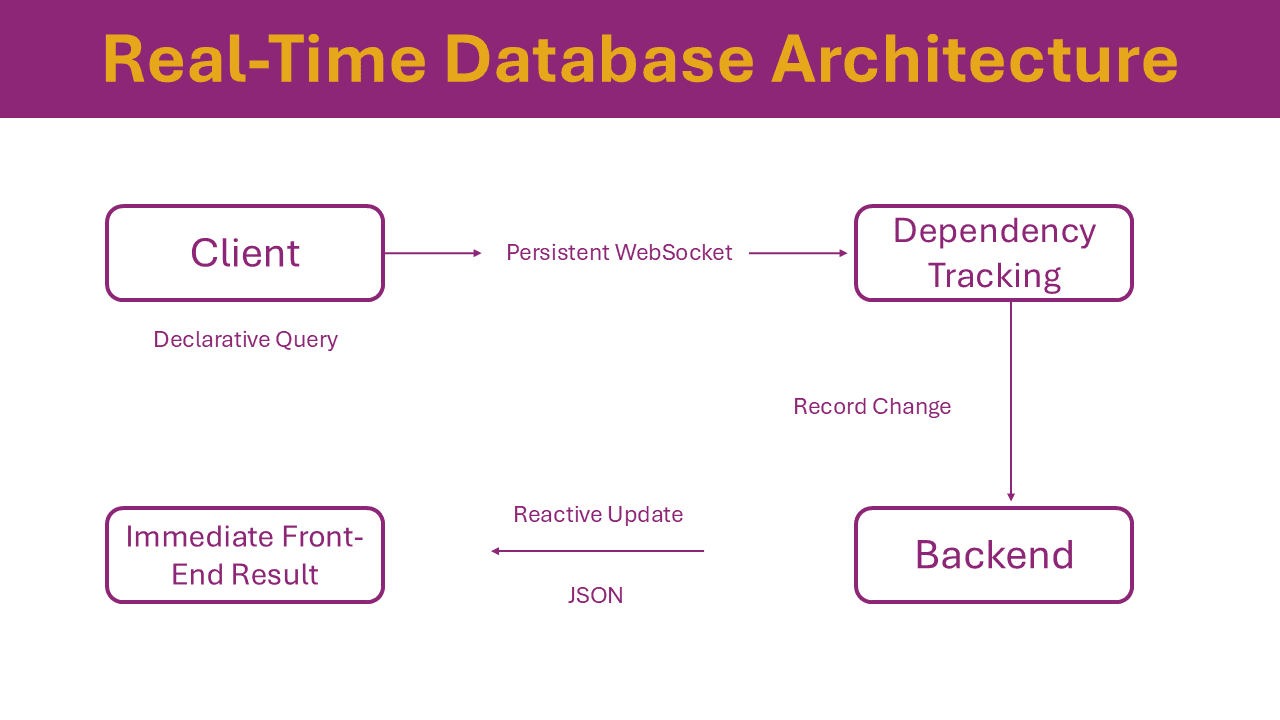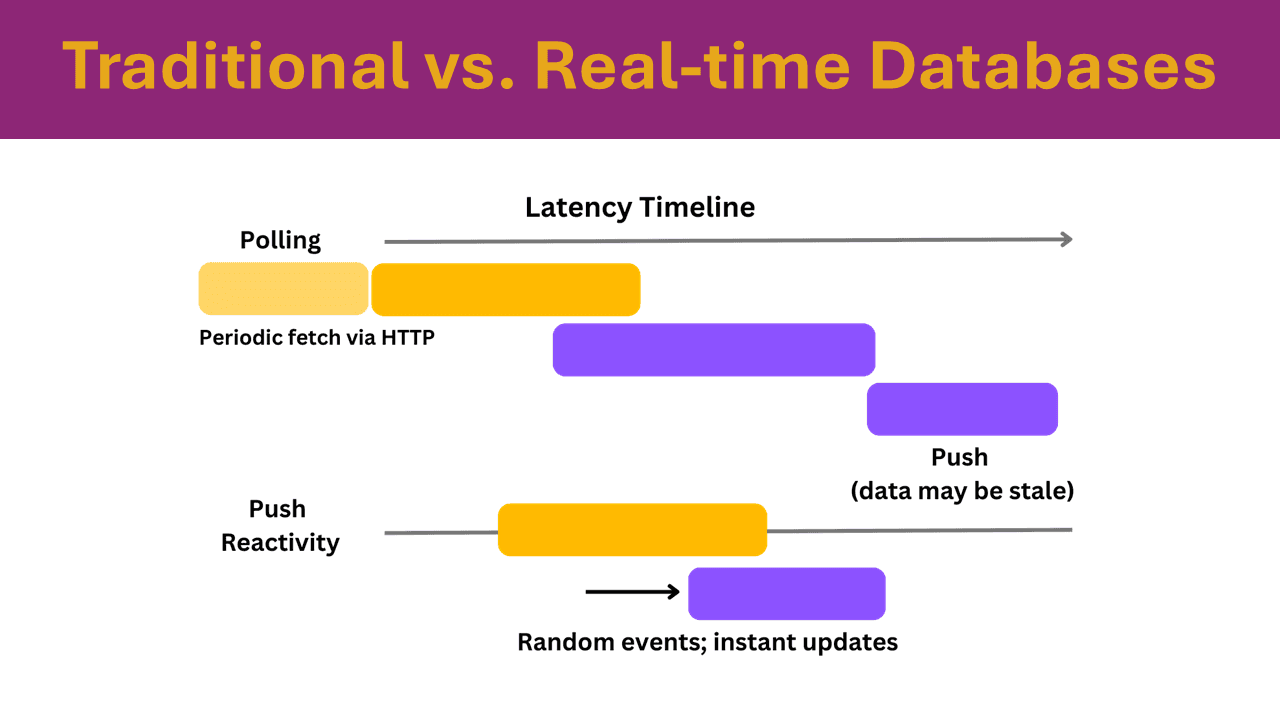
What is a real-time database? (and why your startup probably needs one)
You know the signs: laggy dashboards, unresponsive UIs, and users quietly dropping off. A slow app frustrates your user, but it also costs you growth. For startup founders and first engineers, that kind of friction isn’t just annoying. It’s expensive.
That’s where real-time databases come in.
Instead of polling your backend every few seconds just to check for changes, a real-time database keeps your app in sync automatically. The moment data updates, it’s streamed across users, devices, and systems. No manual refreshes or extra logic needed.
If you’re building a product where speed, reactivity, and UX can make or break user experience, this guide is for you. We’ll break down what a real-time database is, how it works behind the scenes, and why they’re changing the way modern apps are built.
Real-time databases explained: what they are and why they matter
At its core, a real-time database is a backend that keeps your app in sync instantly with live data. Unlike traditional databases, where the client has to constantly ask, “Has anything changed yet?” a real-time database pushes updates the moment data changes.
Real-time databases use a persistent connection (typically WebSockets) to maintain an open channel between client and server. When a user edits a record or a system event triggers a change, the database pushes updates to subscribed clients in real time. Your app stays responsive by default, without polling loops, cache hacks, or manual sync logic.
This real-time flow is powered by event-driven architecture. Data changes act as events that trigger downstream updates across the system. Clients "subscribe" to specific data queries, and the backend "publishes" fresh data when relevant changes occur.
How it works: a quick real-time architecture overview

Most real-time databases consist of four key parts:
- Client subscriptions: The frontend declares interest in specific data (e.g., active users) using declarative queries.
- Persistent connection: WebSockets or a similar protocol keeps the connection open for continuous, bidirectional data flow without the overhead of repeated HTTP requests.
- Dependency tracking: The backend knows which queries depend on which data. When a record changes, only affected clients are notified.
- Reactive updates: The frontend receives structured data updates (often JSON) and reflects them immediately in the UI. It feels like all users are working on the same data… because they are.
For early-stage startups, real-time data is more than a performance win. It’s a competitive edge that lets you move quickly, ship confidently, and meet user expectations with less code and fewer dependencies.
Real-time vs traditional databases: what’s the difference?
The biggest difference between a real-time database and a traditional one is how they deliver updates.

Traditional databases use a request/response model. The client asks for fresh data, and the server responds. To stay current, apps often rely on polling to check for backend updates every few seconds. But this approach can burn resources, add latency, and still leave users with outdated data.
Real-time databases flip the script. Clients subscribe to specific data, and updates are pushed immediately to every subscribed user. The frontend reacts in real-time, and users see the latest state instantly.
This difference isn’t just architectural. It affects your entire product experience.
Key differences
| Feature | Traditional (Polling) | Real-Time (Push/Reactivity) |
|---|---|---|
| Update propagation | Periodic fetch via HTTP | Instant via WebSockets |
| Data freshness | Stale between fetches | Always current |
| Overhead & latency | High CPU/network cost | Efficient, low latency |
| Backend complexity | Manual polling + caching | Auto-sync via reactive queries |
| Scaling demands | Load increases with polling freq | Scales on actual data change |
This table summarizes how reactive, push-based architectures reduce overhead while improving data freshness and scalability.
Why it matters
Real-time and traditional databases take different approaches to speed, scale, and system design. Let’s break down these tradeoffs in more detail:
- Update Propagation: Real-time databases use persistent WebSocket connections to push updates to subscribed clients instantly.. In contrast, traditional systems only send updates when the client asks, leading to lag, even with frequent polling.
- Data Freshness: Real-time systems ensure users always see live data. With traditional polling, stale data can linger between fetch intervals which can break reactive UIs and real-time collaboration.
- Backend Complexity: With real-time databases, you need to wire up sockets, manage subscriptions, and handle cache invalidation. Traditional models are simpler to set up, thanks to mature tools and more predictable processing models.
- Scaling Demands: Polling generates constant traffic, whether data changes or not. This can overwhelm infrastructure as traffic increases. Real-time architectures scale based on actual data changes, reducing unnecessary load.
If your app needs to feel fast and responsive, real-time is built for the job.
Next, let’s look at what makes a real-time database tick.
What makes a real-time database “real-time” under the hood
To users, real-time apps just feel fast. But that instant responsiveness relies on a backend built for scale, concurrency, and low-latency data delivery, especially when updates are flying in from every direction. Here’s what makes it all work:
Persistent, Low-Latency Connections
Real-time databases use persistent WebSocket connections instead of polling. This keeps a long-lived, bidirectional channel open between client and server that lets the database push updates to clients as soon as data changes. It’s what keeps your UI responsive without polling loops or manual refresh buttons.
Event-Driven Subscriptions
Under the hood, most real-time systems follow a publish–subscribe (pub/sub) model. Instead of “fetching” data, clients subscribe to specific queries. When the underlying data changes, the system:
- Determines which queries are affected
- Automatically re-executes them
- Pushes updates only to the relevant clients
It’s scalable, more bandwidth efficient, and ideal for fast-moving apps where shared state changes fast.
Serverless and Scalable by Design
To support high concurrency and global scale, many real-time platforms use a serverless architecture.
This means:
- You don’t have to manage queue workers, socket servers, or autoscaling logic.
- Functions can run concurrently across distributed architecture
- Load is distributed dynamically based on demand.
In Convex, functions are written in TypeScript with full support for custom logic, validation, scheduling, and more. All without managing servers or containers.
Reactive Queries in Convex
Convex makes building real-time apps feel like writing normal TypeScript. You define queries as functions that access the database. Each query automatically tracks its dependencies. When data changes, Convex re-runs only the affected query and pushes the new results to subscribed clients.
This fine-grained reactivity:
- Prevents over-fetching and redundant updates
- Reduces backend compute and network load.
- Guarantees your UI always reflects consistent, up-to-date state, thanks to Convex’s ACID-compliant transactions.
Here’s what that looks like in practice:
1// app/messages.ts
2export const listMessages = query(async ({ db }) => {
3 return await db.query("messages").order("desc").take(10);
4});
5In your frontend:
1const messages = useQuery("listMessages");
2This query automatically updates the UI when new messages are added without writing a single line of socket logic.
To complement reactive reads, Convex uses transactional, consistent mutations. These run server-side, support retries, and trigger any affected queries to re-run instantly. Here's what a typical mutation() might look like:
1// app/messages.ts
2export const sendMessage = mutation({
3 args: { text: v.string() },
4 handler: async ({ db, auth }, args) => {
5 const user = await auth.getUserIdentity();
6 if (!user) throw new Error("Not authenticated");
7
8 await db.insert("messages", {
9 text: args.text,
10 author: user.name,
11 timestamp: Date.now(),
12 });
13 },
14});
15When your app calls sendMessage from the frontend, it inserts a new message into the messages table. Because listMessages depends on that data, Convex knows to re-run the query and update the UI instantly across all subscribed clients.
This tight feedback loop, reactive queries + transactional mutations, gives Convex a powerful yet ergonomic foundation for building real-time applications that scale.
Now let’s explore some of the real-world reasons teams are switching to real-time architectures.
Real-Time from the Start: Key Use Cases for Startup Teams
Real-time databases aren’t just a performance upgrade. They can help you ship faster, simplify your stack, and create product experiences that feel alive from day one. Here’s where they make the biggest impact:
1. Collaborative SaaS tools
If you're building a multiplayer whiteboard, collaborative doc editor, or team dashboard, real-time data keeps users in sync without manual refreshes or merge conflicts. That’s less boilerplate for you and a much smoother experience for your users.
2. E-commerce and retail
Launching a store or marketplace? Real-time databases keep your users in sync with instant inventory updates, synced carts across devices, and real-time support. That means no double-selling, fewer support tickets, and higher trust at checkout.
3. FinTech and banking
If you’re building a finance tool, budgeting app, or anything with balances and transactions, real-time matters. Users expect instant feedback, whether it’s a new charge, a triggered alert, or a fraud warning. Real-time databases make that kind of reliability possible without gluing together polling, caching, and sync logic.
4. Gaming and interactive media
If you're launching a multiplayer game, quiz, or any interactive experience, lag breaks the illusion. Real-time infrastructure ensures that all users see consistent state and interactions. That’s key for fair play, fast feedback, and features like chat, matchmaking, or leaderboard updates.
5. IoT & Logistics
Working on something hardware-adjacent? Real-time databases handle high-throughput telemetry and deliver immediate updates to dashboards and systems. Whether you’re shipping hardware or visualizing field data, this speed drives smarter decisions.
One Stack, One Language
Many real-time platforms require developers to jump between frontend frameworks, backend languages, and sync logic. Convex simplifies your process. Now your teams can build reactive, full-stack apps entirely in TypeScript, making full-stack development faster, cleaner, and way less error-prone.
But going real-time isn’t always simple. Up next: the most common challenges teams face, and how modern platforms are solving them.
Common challenges (and how Convex solves them)
Real-time databases may sound magical, but anyone who’s built one from scratch knows they can be complex, fragile, and tricky to debug. Here’s where teams usually get stuck, and how Convex helps you avoid the mess.
1. Sync bugs, stale cache, and state drift
Polling loops, outdated caches, and race conditions are still a threat in real-time apps, especially under high concurrency. Without transactions, simultaneous updates can overwrite each other, leaving the UI in an inconsistent state.
Convex fix: Convex uses reactive queries and transactional mutations to keep everything in sync. Once you write your state logic, Convex makes sure it runs safely across clients with full ACID guarantees. This means no more syncing edge cases or duplicated logic across tabs.
2. WebSockets are powerful, but fragile
Building your own Websocket layer means managing reconnections, client subscriptions, and message delivery, often with fragile, custom code.
Convex fix: With Convex, you never touch a socket. Just use useQuery()and useMutation() in TypeScript, and Convex handles subscription state, reconnection, and reactivity automatically, all with strong type safety.
3. Debugging Real-Time systems is hard
Live systems are asynchronous by nature. When something breaks, how do you tell what triggered it, what re-ran, and why the UI didn’t update?
Convex fix: Convex built-in developer tools show you which queries are active, what data they depend on, and why they re-ran. You can add server-side logging for deeper visibility. Here’s a TypeScript example of logging inside a reactive query:
1import { query } from "convex/server";
2
3export default query(async ({ db, log }) => {
4 log.info("Fetching messages with reactivity enabled");
5 return await db.query("messages").collect();
6});
7And here’s how you might implement defensive UI logic in the client:
1import { useQuery } from "convex/react";
2import { api } from "../convex/_generated/api";
3
4const messages = useQuery(api.messages.listMessages);
5
6if (messages === undefined) {
7 return <p>Loading...</p>; // Initial fetch
8}
9
10if (messages.length === 0) {
11 return <p>No messages yet.</p>; // Graceful empty state
12}
13These patterns make real-time behavior easier to trace and control, without the guesswork.
4. Tradeoffs Between Speed, Simplicity, and Consistency
Most real-time databases force you to choose:
- Want speed? You sacrifice transactional safety.
- Want strong consistency? Prepare for complexity.
- Want simplicity? You might hit limits as you scale.
That triangle is hard to balance. And few platforms deliver all three.
How Convex helps: Convex is designed so you don’t have to pick. You get:
- Speed through reactive queries and WebSockets
- Simplicity with full-stack TypeScript and a serverless backend
- Consistency via built-in ACID-compliant transactions
That means you can ship fast, stay correct, and scale cleanly without rewriting your sync logic at every growth stage.
What infrastructure do you need for real-time data?
Building a real-time system from scratch usually means stitching together a fragile backend stack and hoping it scales. Here’s what that typically looks like
- WebSocket server: For persistent, low-latency client connections, often custom-built with libraries like
wsin Node.js or frameworks like Phoenix (Elixir). - Pub/Sub system: Tools like Redis Pub/Sub, Kafka, or NATS to broadcast updates across nodes. Powerful but ops-heavy and tricky to scale..
- Change Data Capture (CDC): streaming changes via replication logs (e.g., PostgreSQL WAL or Debezium), then turning them into update events.
- **Manual caching & invalidation: **Prevents over-fetching, but error-prone, especially with multi-user write conflicts.
- Client-side state management: Custom subscription logic wired to state libraries (e.g., Redux, Zustand) to keep UIs updated.
- Auto scaling logic: WebSocket load balancing requires sticky sessions and smart routing via NGINX, Envoy, or custom proxies.
- Monitoring and observability: Tracing dropped updates, latency spikes, or sync issues means rolling your own metrics and logging systems.
That’s a lot of moving parts, especially when your team is small and velocity matters.
What Convex handles for you
Convex replaces that complexity with a fully managed real-time backend. You write reactive TypeScript functions, and Convex takes care of the infrastructure. Out of the box, Convex provides:
Built-in Real-time stack
- WebSocket orchestration: Region-aware, load-balanced connections. No sticky sessions or custom socket logic.
- Reactive query engine: Convex tracks query dependencies and automatically re-runs them when the underlying data changes.
- Isolated, auto-scaling functions: Stateless backend logic scales on demand with built-in fault tolerance.
- ACID-compliant updates: Transactions ensure clients always see a consistent view of the data.
- Efficient fan-out: Only affected clients get updates—no noisy channel broadcasting.
Built-in developer ergonomics
- First-class observability: Logs, errors, and metrics tied to function executions and queries.
- End-to-end TypeScript: Frontend and backend in one language, with full type safety.
- Zero-config deploys: No infra to manage, no scripts to maintain. Everything lives in the Convex runtime.
Build Even Faster with Convex Chef
Need to get something running today? Convex Chef spins up a production-ready backend in minutes with real-time queries, mutations, and built-in auth. No infrastructure code required. Perfect for getting your MVP or internal tool off the ground fast.
TL;DR: Real-time is the new normal
Real-time isn’t a premium feature anymore. Whether it's a shared doc, a live dashboard, or a financial update, it’s what users expect.
But building a real-time system from scratch is hard, unless your platform is built for it.
Convex gives you a fully reactive, ACID-safe backend that syncs automatically, runs entirely in TypeScript, and scales with you, so you can ship faster without worrying about infrastructure.
Try Convex today free, and be live in minutes; your full-stack starter, ready to sync.
Convex is the backend platform with everything you need to build your full-stack AI project. Cloud functions, a database, file storage, scheduling, workflow, vector search, and realtime updates fit together seamlessly.